 Facebook
Facebook
 X
X
 Instagram
Instagram
 TikTok
TikTok
 Youtube
Youtube
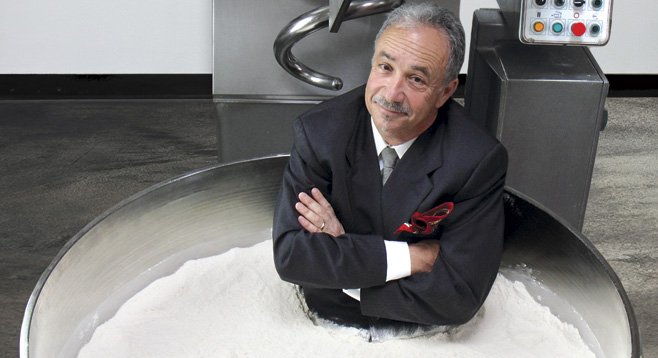
Behind the glass that separates the kitchen from the customers at Bread & Cie Bakery and Café in Hillcrest, steam heat pours from the oven. Bakers in long aprons and French bonnets lift loaves of artisan bread from the oven and place them into baskets.
Patrons gather at the wraparound counter, pointing to this loaf or that quiche as the line to order swells. Order-takers with earrings and tattoos help the customers.
If he sees the line beginning to snake, Charles Kaufman, owner of Bread & Cie, assists the staff in taking orders while entertaining hungry people by cavorting and telling jokes. At 62, he moves nimbly around his bakery. Kaufman looks distinguished, despite an REI outfit and Merrill Walkabouts. He swears he “never intended to be a bread-maker.”
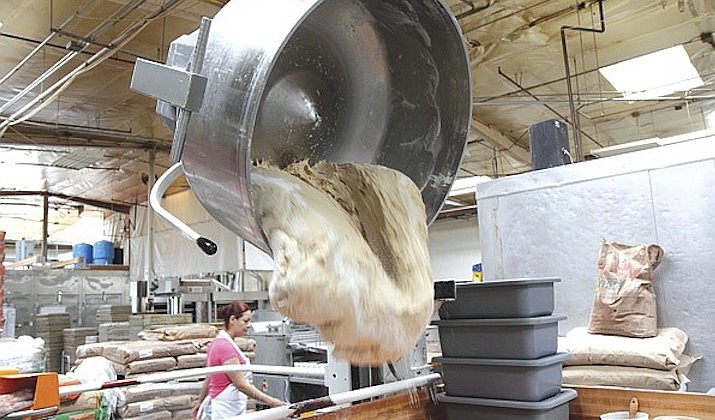
Kaufman grew up in New York City. When he was eight years old, his mom took him to see his first show, Ethel Merman in Gypsy. Upon viewing that “first set of boobies in the strip-dance scene, I knew exactly what field I would go into,” Kaufman laughs.
Despite a stutter, he dreamed of being an actor; his hopes and ambitions were encouraged. “My dad was an independent lawyer who moonlighted in amateur theater,” Kaufman says. “My mom was an unconventional narcissist with a passion for Broadway. It fit.”
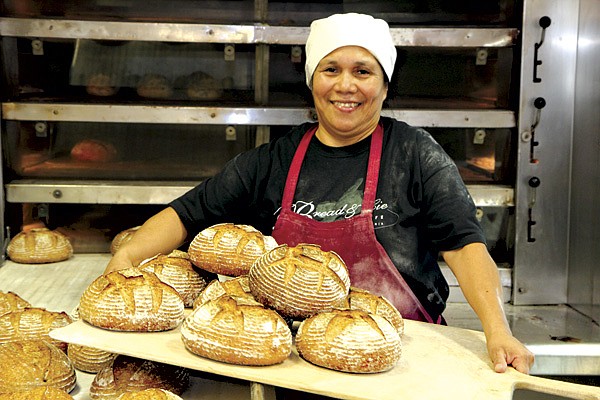
Kaufman grew up in midtown Manhattan. His address, a brownstone on 65th, between Park and Third avenues, screamed privilege. At five, he was sent to Trinity Academy, one of the best all-boys’ schools on the Upper West Side. “At the time, I didn’t think I was privileged. I didn’t think it was a privilege to be away from my family from 8:00 a.m. until 6:00 p.m. every day.”
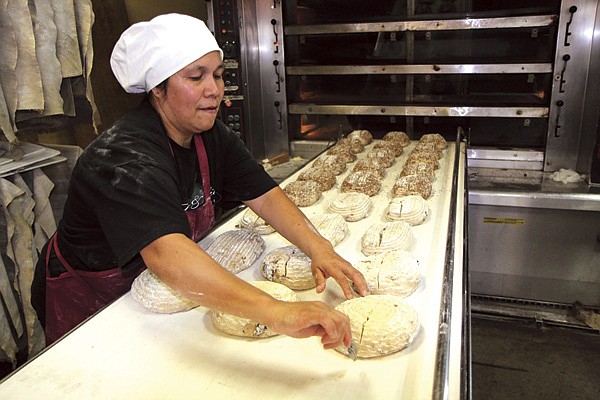
Kaufman tried to get his parents’ attention when he was home. “My parents were very busy with work and philanthropy.” He found his way by being funny. For a year, he carried a puppet around and talked in a puppet voice. “That fell flat after awhile, especially after my parents brought me to a shrink.”
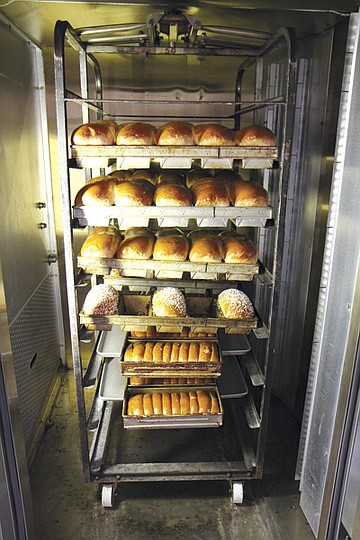
He began telling jokes. His mom took notice. “I lived for making her laugh, and I knew very young that if I could make her laugh, she’d be pleased with me. There was nothing quite like that feeling of approval and comfort.” Also, if he told a joke and people laughed — validation that they enjoyed his company — he wouldn’t stutter.
Kaufman enrolled in classes at the Stella Adler School of Acting. “I remember being onstage for scene-study for what felt like hours, as my partner would wait for me to say my lines.” He grimaces. “My acting career didn’t last long.”
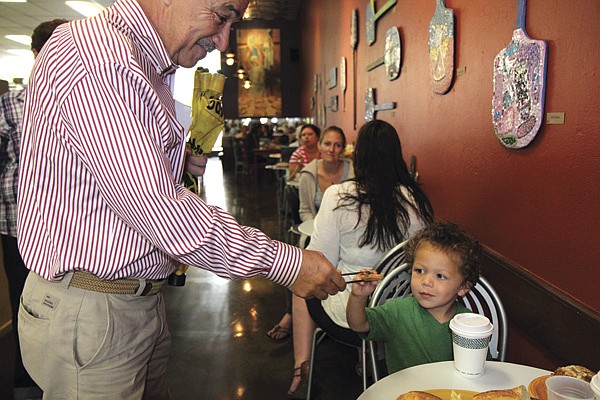
In high school, he was class president. “I lost many nights’ sleep before speeches, but I knew if I could just make them laugh, I could get through it.”
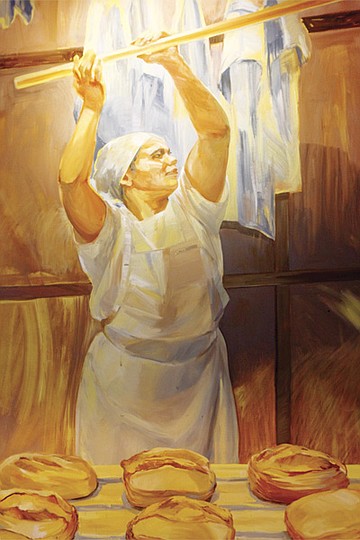
He graduated from high school in 1967 and went on to college at the University of Connecticut. He was accepted into UCLA’s graduate film school, graduating with honors in 1973. “My first real-world job out of film school was as an intern for NBC Studios in Burbank.
“I was given the clandestine task of driving to Bob Hope’s house to pick up paper ‘receipts’ that contained the topics Hope wanted to cover in The Bob Hope Show.” It was live television, and Hope left nothing to chance: the receipts had to be delivered in haste to Hope’s writers. “He was very secretive and didn’t want his topics getting out.”
Every day, Kaufman would drive to Hope’s house in Burbank, pick up the slips, then drop a slip off at each of the show’s writers’ homes. Some lived in the Valley, some across town in Culver City, near the airport. “The trip would take hours. I’d get lost all the time.” Kaufman would wait for the writers to come up with material, then he’d drive it back to Bob.
“Sitting in traffic in my red 1968 Volvo, on the dusty, hot, polluted streets of Los Angeles was torture. In order to keep myself entertained, I’d peek at Mr. Hope’s topics. If the receipts said he wanted jokes on ‘inflation’ or ‘Nixon,’ I’d come up with my own jokes and tell them to a make-believe audience. Other drivers must’ve thought I was nuts.”
He began writing his own gags and sneaking them into the pile with the paid writers’ submissions. When Kaufman wrote, he didn’t have a speech impediment. “I had great timing on paper.”
Hope and the producer of the show figured out that additional scribbled jokes were coming in on the sly. After reading Kaufman’s gags, they knew their intern had comedic talent. They offered to hire him as a writer, as long as he passed a typing test.
Kaufman didn’t know how to type, but “I told them I did.” Determined to begin his writing career, he spent three days hunkered over a Remington typewriter, teaching himself. “This was a job writing jokes for Bob Hope. I was going to walk barefoot over hot coals, if I had to.”
He passed the test, got the job, and worked as a writer on The Bob Hope Show for four years. What he remembers most about that time is how Bob Hope wouldn’t laugh when he thought something was funny. He’d read through the “gags,” checking off the pieces he wanted to use by saying “That’s funny, that’s not funny, that’s funny” as he went down each writer’s list. “This guy was such a pro, he didn’t have to laugh, he just knew.”
To this day, Kaufman doesn’t think Hope knew his name. “I tried to distinguish myself by wearing a jacket and tie every day, but it only made the other writers think I was a twerp.” He wanted to make an impression, stand out somehow. Now, he laughs: he made such a big impression that, when the show went off the air, “Mr. Hope gave me a keychain with his picture on it.”
After The Bob Hope Show ended in 1978, Kaufman moved back to New York. He could’ve stayed in Los Angeles and worked his way up the ladder in the studio system, until finally given permission to direct a film — or he could move back to New York, learn everything possible about the film business, and finance a film on his own.
He landed a temporary job in New York doing “sound” on a small independent film. “I knew that part of the reason I stuttered had to do with my hearing. And even though my hearing was technically not quite right, I had to take the job and make it work.”
He also took a job assisting an agent who sold rights to American films all over the world. The agent brought Kaufman to the main venue at the time, Cannes Film Festival, where distributors screen films, then make offers to buy the rights for certain territories.
Cannes Film Festival was where Kaufman learned the sales part of the industry. His gregarious personality and ability to be funny served him well. “I focused on getting to know the people who bought the films abroad.” Kaufman raises his eyebrows. “I remember one screening, my boss hired 25 Parisian prostitutes to sit in every other seat in the theater during the showing. This way, the agent knew that when the lights in the theater went down, the buyers would be ‘distracted.’ This got more buyers into his screenings and many more offers to buy his films. I didn’t want to have to employ the seedier part of selling, so I made friendships.”
Kaufman took everything he’d learned in graduate school, working behind the scenes and selling films abroad, and put together an idea for his first film. He wanted to start with a low-budget “B” film. “They didn’t require big actors or millions of dollars. They were typically genre exploitation films with low budgets, short shooting schedules, short running times, and minimal post-production efforts.”
He crafted a storyboard of a horror film and “carried it around to everyone I knew,” to raise enough cash to make his film. He even pitched it to his dad, who at first scoffed at the idea.
“After I raised a majority of the money on my own, my father was impressed. My dad thought that if I was this passionate and determined about the project, then he was going to help. He had the money. Although he knew it wasn’t Oscar material, he would finally support me.” Kaufman began production; he even offered his dad a small part. His dad accepted, and thereafter acted in every film Kaufman made.
This was the 1970s. B films, especially horror movies, were raking it in at the box office. Exploitation films developed devout followers, and theaters and distribution companies were snapping them up. Halloween had just grossed over $80 million worldwide; it was made for $320,000.
To Kaufman’s delight and “quite frankly, amazement,” Mona, the first film he wrote and directed, was made for $15,000 and sold for $250,000. With this initial success as a writer/director, Kaufman “wanted to buy a vacation home in the Adirondacks.”
He sought advice from his father, who “was a very smart guy, with good street sense.” His dad said, “Use the money you earned to [film] what you want. That money will buy your freedom. Make it last. It will extend the length of time where you can work for yourself. It will support you.”
Kaufman didn’t buy the vacation home. He took his father’s advice and used his profit to make more films. Once the films were “in the can,” he would get them into theaters, sell them to other venues, and make enough money for the next project.
When The Texas Chainsaw Massacre and Halloween made big profits, the major studios took notice. They made their own B films, with bigger and better budgets and storylines.
“The smaller filmmakers couldn’t keep up,” Kaufman says. The studios “monopolized the low-budget genre industry, and little guys like me began to struggle.” Kaufman’s films, along with those of many other independent film companies, were locked out, market after market.
His wife Dori wasn’t all that disappointed. Kaufman’s films left “something to be desired,” she says. Kaufman knew this. His movies were funny yet gruesome. “I made the wise decision not to let Dori see any of my films until after we were married. She was über-intelligent, a Phi Beta Kappa graduate of UC Berkeley, and working for a school for the blind. I didn’t want to scare her away.”
Dori and Kaufman met in 1988. Kaufman was 39, Dori was 38. Kaufman had been the fifth wheel on too many bowling double-dates when a friend told him about Dori. Perhaps there could be six players? She slipped him Dori’s phone number. Kaufman called.
They had several long conversations before meeting face-to-face. Dori ignored Kaufman’s stutter and laughed at all of his jokes. “She was the only girl who wanted to see my full face without a mustache. That should tell you something.”
Dori remembers: “We discovered we grew up within six miles of each other in New York. Once we began talking, I felt like I had known him my whole life.”
After six months of dating, they got engaged. Three months later, they married at their engagement party at the Plaza in New York. Both had headstrong mothers who intended to have their way with how, where, and what type of wedding Dori and Kaufman should have. The young couple had their own ideas.
The party was in a ballroom at the Plaza. The families met for the first time. Both sides attended en masse, or, as Kaufman jokes, “en mess.”
After awhile, people began to notice that Dori had disappeared. Kaufman quieted the party. He addressed them as seriously as he was able. “I have an announcement. As you all can see, Dori has left the party. You’re ‘family,’ and I have to be honest with you — this engagement thing just isn’t working out.”
After an audible gasp, he continued: “As a result, Dori and I have decided we’ll be getting married, right here, right now.”
Dori had only gone to the room next door to don her bridal gown.
Kaufman had a wedding-day surprise for Dori. He’d planned to sneak into the bathroom and shave his mustache so he’d be clean-shaven for the wedding vows; she’d be able to see all of his face. But he was so nervous, he cut himself. “It was really bad; blood was all over the place. I couldn’t stop the bleeding. I had to lie down on the bathroom floor as my best friend administered first aid. The wedding had to be postponed for 45 minutes.”
Dori didn’t know what was going on. She assumed he was refusing to come out to get married. But once Kaufman’s bleeding was under control, his best friend, nurse, and legal minister performed the ceremony as planned.
Fourteen months later, after filming Jakarta in Indonesia and editing it in Los Angeles, Kaufman found himself back at Cannes, trying to make a sale. “No one was interested,” he says. “The sales were nothing compared to my earlier films.” It was a huge blow, especially after the success of Kaufman’s Mother’s Day, which had grossed $30 million worldwide.
In 1991, he and Dori moved to Los Angeles. Kaufman took some time off. The film industry had depleted him not only of money but his spirit. And Dori was pregnant. They were going to have a baby, a girl.
In the months leading up to the birth of his daughter, Kaufman looked to the future. “I didn’t want to be making comedic low-rent horror films at 60, with a teenage daughter [at home]. I needed to find another career.
“My dad had nurtured that entrepreneurial passion in me. I knew I would make a lousy employee and wanted to avoid the further humiliation of being fired. Growing up in Manhattan, I was exposed to every type of food imaginable.”
Whenever his mother went to the bakery to buy fresh bread for the family, Kaufman would tag along, anxious to watch the bakers knead and shape the dough.
Later, while traveling to Cannes every year, he’d visit bakeries and sample varieties of artisan bread. The bakeries were warm. They were places where family and friends gathered.
“The bakers enjoyed what they were doing,” he says. “There was honor in baking a great loaf of bread and sharing it with others. I decided that I was going to learn how to make this kind of bread. Then I was going to build a bakery — how hard could it be?”
But, he admits, “I was older, with a kid on the way. I wasn’t sure I still had the guts to do it. I knew that to do it right, I had to immerse myself in this world the way I’d immersed myself in the film world. I scoured the country for bakeries where I could apprentice.”
Once again relying on humor to break the ice, Kaufman would call, introduce himself, and try to stay a few thoughts ahead, so he wouldn’t stutter. “I’d offer to work for free in exchange for learning how they made their bread.”
He was amazed by the bakers’ generosity. He was used to the film industry, where if you have a groundbreaking way of shooting or editing, you keep it for your own films. “In the culinary world,” he says, “bakers and chefs were gloriously sharing ideas and secrets. It was mind-boggling.”
He spent the next two years traveling around the United States, learning the “true art” of bread-making. “Bread became my cruel mistress.” He worked at Buckeye Bakery in Atlanta; the Firehouse Bakery in Alexandria, Virginia; Grace Baking in Berkeley, California. He worked at La Brea Bakery in Los Angeles, with Nancy Silverton, “who was extremely forthcoming.”
Kaufman says, “I was going to open up a bakery where I could combine my cinematic background with my culinary vision. I wanted people to witness the mixing, kneading, shaping, and the baking of the dough. I wanted my customers to smell the fresh flour, the dough before and after it rose, to get lost in the aroma once it came out of the oven. I was going to put on a show.”
Kaufman and Dori wanted to get out of Hollywood. They’d visited San Diego for years and believed it would be a great place to raise their daughter Kira. In San Diego, they felt they’d “landed in a big city with the feeling of a small town.” They could begin their dream here.
It was 1993. Hillcrest was quiet. There were few hip stores, coffee shops, or restaurants. The Kaufmans were able to rent enough space to house an Italian, 50,000-pound, gas-fired, steam-injection, four-deck Tibiletti oven. It would be the most important tool of their bakery.
They custom-built Bread & Cie Bakery to fit the hearth-deck Tibiletti, which is over two stories tall and 15 feet wide. The oven bakes 50 loaves of bread at once. It must be controlled by a human being and watched with a baker’s eye.
Kaufman and Dori worked side-by-side. Kira’s first playground was the bakery. The family dug in and put down roots. They got involved in the community. They helped build Explorer Elementary; they remained on the board of directors for years.
They grew Bread & Cie slowly. Kaufman sold his fresh bread the way he used to sell films: “Only this time around, my product was more tasteful.” The bakery didn’t advertise; it was all word-of-mouth marketing.
When KPBS asked Kaufman for an interview, he agreed. “We didn’t have any advertising out there, and now I was going to be on the radio. People depended on me. I didn’t want to blow it. I didn’t sleep the whole week before, afraid I would stutter. I didn’t want to distract people from learning that my bread was wholesome and delicious.”
Once again, Kaufman relied on humor. He got through the interview without stuttering.
They continued to grow the business, supplying bread to local restaurants and food stores such as Henry’s, Whole Foods, Bristol Farms, and certain Vons, Albertsons, and Ralphs. They also sold bread and bakery items at San Diego farmers’ markets, in La Mesa, Solana Beach, Hillcrest, and Little Italy. Jeff, one of Kaufman’s devoted “ambassadors,” keeps him informed on how the community is enjoying his bread.
Bread & Cie added a wholesale facility, where the grocery-store bread is baked, and where pastries are shaped; it’s where talented bakers try out new recipes for pies and cakes. Billboard-sized posters of Kaufman’s films adorn the towering walls. The posters remind him of where he came from.
The name “Cie” was also pulled from Kaufman’s childhood memories — until he was eight, he had Celiac disease.
Kaufman started Bread & Cie with six employees. On the first day they were open for business, he “sold 35 loaves of bread.” Now, almost 20 years later, he employs “129 San Diegans, and on a busy weekend day, we’ll bake over 10,000 loaves of bread.”
His daughter Kira just graduated from high school. She’s decided to take time off before college to pursue her dream of being a ballroom dancer. Kaufman supports that dream.
“After all,” he says, “I followed mine.”
He adds, “The best thing in life is to have passion for something and go after it. You never know where that passion will take you.”


Behind the glass that separates the kitchen from the customers at Bread & Cie Bakery and Café in Hillcrest, steam heat pours from the oven. Bakers in long aprons and French bonnets lift loaves of artisan bread from the oven and place them into baskets.
Patrons gather at the wraparound counter, pointing to this loaf or that quiche as the line to order swells. Order-takers with earrings and tattoos help the customers.
If he sees the line beginning to snake, Charles Kaufman, owner of Bread & Cie, assists the staff in taking orders while entertaining hungry people by cavorting and telling jokes. At 62, he moves nimbly around his bakery. Kaufman looks distinguished, despite an REI outfit and Merrill Walkabouts. He swears he “never intended to be a bread-maker.”

Kaufman grew up in New York City. When he was eight years old, his mom took him to see his first show, Ethel Merman in Gypsy. Upon viewing that “first set of boobies in the strip-dance scene, I knew exactly what field I would go into,” Kaufman laughs.
Despite a stutter, he dreamed of being an actor; his hopes and ambitions were encouraged. “My dad was an independent lawyer who moonlighted in amateur theater,” Kaufman says. “My mom was an unconventional narcissist with a passion for Broadway. It fit.”

Kaufman grew up in midtown Manhattan. His address, a brownstone on 65th, between Park and Third avenues, screamed privilege. At five, he was sent to Trinity Academy, one of the best all-boys’ schools on the Upper West Side. “At the time, I didn’t think I was privileged. I didn’t think it was a privilege to be away from my family from 8:00 a.m. until 6:00 p.m. every day.”

Kaufman tried to get his parents’ attention when he was home. “My parents were very busy with work and philanthropy.” He found his way by being funny. For a year, he carried a puppet around and talked in a puppet voice. “That fell flat after awhile, especially after my parents brought me to a shrink.”

He began telling jokes. His mom took notice. “I lived for making her laugh, and I knew very young that if I could make her laugh, she’d be pleased with me. There was nothing quite like that feeling of approval and comfort.” Also, if he told a joke and people laughed — validation that they enjoyed his company — he wouldn’t stutter.
Kaufman enrolled in classes at the Stella Adler School of Acting. “I remember being onstage for scene-study for what felt like hours, as my partner would wait for me to say my lines.” He grimaces. “My acting career didn’t last long.”

In high school, he was class president. “I lost many nights’ sleep before speeches, but I knew if I could just make them laugh, I could get through it.”

He graduated from high school in 1967 and went on to college at the University of Connecticut. He was accepted into UCLA’s graduate film school, graduating with honors in 1973. “My first real-world job out of film school was as an intern for NBC Studios in Burbank.
“I was given the clandestine task of driving to Bob Hope’s house to pick up paper ‘receipts’ that contained the topics Hope wanted to cover in The Bob Hope Show.” It was live television, and Hope left nothing to chance: the receipts had to be delivered in haste to Hope’s writers. “He was very secretive and didn’t want his topics getting out.”
Every day, Kaufman would drive to Hope’s house in Burbank, pick up the slips, then drop a slip off at each of the show’s writers’ homes. Some lived in the Valley, some across town in Culver City, near the airport. “The trip would take hours. I’d get lost all the time.” Kaufman would wait for the writers to come up with material, then he’d drive it back to Bob.
“Sitting in traffic in my red 1968 Volvo, on the dusty, hot, polluted streets of Los Angeles was torture. In order to keep myself entertained, I’d peek at Mr. Hope’s topics. If the receipts said he wanted jokes on ‘inflation’ or ‘Nixon,’ I’d come up with my own jokes and tell them to a make-believe audience. Other drivers must’ve thought I was nuts.”
He began writing his own gags and sneaking them into the pile with the paid writers’ submissions. When Kaufman wrote, he didn’t have a speech impediment. “I had great timing on paper.”
Hope and the producer of the show figured out that additional scribbled jokes were coming in on the sly. After reading Kaufman’s gags, they knew their intern had comedic talent. They offered to hire him as a writer, as long as he passed a typing test.
Kaufman didn’t know how to type, but “I told them I did.” Determined to begin his writing career, he spent three days hunkered over a Remington typewriter, teaching himself. “This was a job writing jokes for Bob Hope. I was going to walk barefoot over hot coals, if I had to.”
He passed the test, got the job, and worked as a writer on The Bob Hope Show for four years. What he remembers most about that time is how Bob Hope wouldn’t laugh when he thought something was funny. He’d read through the “gags,” checking off the pieces he wanted to use by saying “That’s funny, that’s not funny, that’s funny” as he went down each writer’s list. “This guy was such a pro, he didn’t have to laugh, he just knew.”
To this day, Kaufman doesn’t think Hope knew his name. “I tried to distinguish myself by wearing a jacket and tie every day, but it only made the other writers think I was a twerp.” He wanted to make an impression, stand out somehow. Now, he laughs: he made such a big impression that, when the show went off the air, “Mr. Hope gave me a keychain with his picture on it.”
After The Bob Hope Show ended in 1978, Kaufman moved back to New York. He could’ve stayed in Los Angeles and worked his way up the ladder in the studio system, until finally given permission to direct a film — or he could move back to New York, learn everything possible about the film business, and finance a film on his own.
He landed a temporary job in New York doing “sound” on a small independent film. “I knew that part of the reason I stuttered had to do with my hearing. And even though my hearing was technically not quite right, I had to take the job and make it work.”
He also took a job assisting an agent who sold rights to American films all over the world. The agent brought Kaufman to the main venue at the time, Cannes Film Festival, where distributors screen films, then make offers to buy the rights for certain territories.
Cannes Film Festival was where Kaufman learned the sales part of the industry. His gregarious personality and ability to be funny served him well. “I focused on getting to know the people who bought the films abroad.” Kaufman raises his eyebrows. “I remember one screening, my boss hired 25 Parisian prostitutes to sit in every other seat in the theater during the showing. This way, the agent knew that when the lights in the theater went down, the buyers would be ‘distracted.’ This got more buyers into his screenings and many more offers to buy his films. I didn’t want to have to employ the seedier part of selling, so I made friendships.”
Kaufman took everything he’d learned in graduate school, working behind the scenes and selling films abroad, and put together an idea for his first film. He wanted to start with a low-budget “B” film. “They didn’t require big actors or millions of dollars. They were typically genre exploitation films with low budgets, short shooting schedules, short running times, and minimal post-production efforts.”
He crafted a storyboard of a horror film and “carried it around to everyone I knew,” to raise enough cash to make his film. He even pitched it to his dad, who at first scoffed at the idea.
“After I raised a majority of the money on my own, my father was impressed. My dad thought that if I was this passionate and determined about the project, then he was going to help. He had the money. Although he knew it wasn’t Oscar material, he would finally support me.” Kaufman began production; he even offered his dad a small part. His dad accepted, and thereafter acted in every film Kaufman made.
This was the 1970s. B films, especially horror movies, were raking it in at the box office. Exploitation films developed devout followers, and theaters and distribution companies were snapping them up. Halloween had just grossed over $80 million worldwide; it was made for $320,000.
To Kaufman’s delight and “quite frankly, amazement,” Mona, the first film he wrote and directed, was made for $15,000 and sold for $250,000. With this initial success as a writer/director, Kaufman “wanted to buy a vacation home in the Adirondacks.”
He sought advice from his father, who “was a very smart guy, with good street sense.” His dad said, “Use the money you earned to [film] what you want. That money will buy your freedom. Make it last. It will extend the length of time where you can work for yourself. It will support you.”
Kaufman didn’t buy the vacation home. He took his father’s advice and used his profit to make more films. Once the films were “in the can,” he would get them into theaters, sell them to other venues, and make enough money for the next project.
When The Texas Chainsaw Massacre and Halloween made big profits, the major studios took notice. They made their own B films, with bigger and better budgets and storylines.
“The smaller filmmakers couldn’t keep up,” Kaufman says. The studios “monopolized the low-budget genre industry, and little guys like me began to struggle.” Kaufman’s films, along with those of many other independent film companies, were locked out, market after market.
His wife Dori wasn’t all that disappointed. Kaufman’s films left “something to be desired,” she says. Kaufman knew this. His movies were funny yet gruesome. “I made the wise decision not to let Dori see any of my films until after we were married. She was über-intelligent, a Phi Beta Kappa graduate of UC Berkeley, and working for a school for the blind. I didn’t want to scare her away.”
Dori and Kaufman met in 1988. Kaufman was 39, Dori was 38. Kaufman had been the fifth wheel on too many bowling double-dates when a friend told him about Dori. Perhaps there could be six players? She slipped him Dori’s phone number. Kaufman called.
They had several long conversations before meeting face-to-face. Dori ignored Kaufman’s stutter and laughed at all of his jokes. “She was the only girl who wanted to see my full face without a mustache. That should tell you something.”
Dori remembers: “We discovered we grew up within six miles of each other in New York. Once we began talking, I felt like I had known him my whole life.”
After six months of dating, they got engaged. Three months later, they married at their engagement party at the Plaza in New York. Both had headstrong mothers who intended to have their way with how, where, and what type of wedding Dori and Kaufman should have. The young couple had their own ideas.
The party was in a ballroom at the Plaza. The families met for the first time. Both sides attended en masse, or, as Kaufman jokes, “en mess.”
After awhile, people began to notice that Dori had disappeared. Kaufman quieted the party. He addressed them as seriously as he was able. “I have an announcement. As you all can see, Dori has left the party. You’re ‘family,’ and I have to be honest with you — this engagement thing just isn’t working out.”
After an audible gasp, he continued: “As a result, Dori and I have decided we’ll be getting married, right here, right now.”
Dori had only gone to the room next door to don her bridal gown.
Kaufman had a wedding-day surprise for Dori. He’d planned to sneak into the bathroom and shave his mustache so he’d be clean-shaven for the wedding vows; she’d be able to see all of his face. But he was so nervous, he cut himself. “It was really bad; blood was all over the place. I couldn’t stop the bleeding. I had to lie down on the bathroom floor as my best friend administered first aid. The wedding had to be postponed for 45 minutes.”
Dori didn’t know what was going on. She assumed he was refusing to come out to get married. But once Kaufman’s bleeding was under control, his best friend, nurse, and legal minister performed the ceremony as planned.
Fourteen months later, after filming Jakarta in Indonesia and editing it in Los Angeles, Kaufman found himself back at Cannes, trying to make a sale. “No one was interested,” he says. “The sales were nothing compared to my earlier films.” It was a huge blow, especially after the success of Kaufman’s Mother’s Day, which had grossed $30 million worldwide.
In 1991, he and Dori moved to Los Angeles. Kaufman took some time off. The film industry had depleted him not only of money but his spirit. And Dori was pregnant. They were going to have a baby, a girl.
In the months leading up to the birth of his daughter, Kaufman looked to the future. “I didn’t want to be making comedic low-rent horror films at 60, with a teenage daughter [at home]. I needed to find another career.
“My dad had nurtured that entrepreneurial passion in me. I knew I would make a lousy employee and wanted to avoid the further humiliation of being fired. Growing up in Manhattan, I was exposed to every type of food imaginable.”
Whenever his mother went to the bakery to buy fresh bread for the family, Kaufman would tag along, anxious to watch the bakers knead and shape the dough.
Later, while traveling to Cannes every year, he’d visit bakeries and sample varieties of artisan bread. The bakeries were warm. They were places where family and friends gathered.
“The bakers enjoyed what they were doing,” he says. “There was honor in baking a great loaf of bread and sharing it with others. I decided that I was going to learn how to make this kind of bread. Then I was going to build a bakery — how hard could it be?”
But, he admits, “I was older, with a kid on the way. I wasn’t sure I still had the guts to do it. I knew that to do it right, I had to immerse myself in this world the way I’d immersed myself in the film world. I scoured the country for bakeries where I could apprentice.”
Once again relying on humor to break the ice, Kaufman would call, introduce himself, and try to stay a few thoughts ahead, so he wouldn’t stutter. “I’d offer to work for free in exchange for learning how they made their bread.”
He was amazed by the bakers’ generosity. He was used to the film industry, where if you have a groundbreaking way of shooting or editing, you keep it for your own films. “In the culinary world,” he says, “bakers and chefs were gloriously sharing ideas and secrets. It was mind-boggling.”
He spent the next two years traveling around the United States, learning the “true art” of bread-making. “Bread became my cruel mistress.” He worked at Buckeye Bakery in Atlanta; the Firehouse Bakery in Alexandria, Virginia; Grace Baking in Berkeley, California. He worked at La Brea Bakery in Los Angeles, with Nancy Silverton, “who was extremely forthcoming.”
Kaufman says, “I was going to open up a bakery where I could combine my cinematic background with my culinary vision. I wanted people to witness the mixing, kneading, shaping, and the baking of the dough. I wanted my customers to smell the fresh flour, the dough before and after it rose, to get lost in the aroma once it came out of the oven. I was going to put on a show.”
Kaufman and Dori wanted to get out of Hollywood. They’d visited San Diego for years and believed it would be a great place to raise their daughter Kira. In San Diego, they felt they’d “landed in a big city with the feeling of a small town.” They could begin their dream here.
It was 1993. Hillcrest was quiet. There were few hip stores, coffee shops, or restaurants. The Kaufmans were able to rent enough space to house an Italian, 50,000-pound, gas-fired, steam-injection, four-deck Tibiletti oven. It would be the most important tool of their bakery.
They custom-built Bread & Cie Bakery to fit the hearth-deck Tibiletti, which is over two stories tall and 15 feet wide. The oven bakes 50 loaves of bread at once. It must be controlled by a human being and watched with a baker’s eye.
Kaufman and Dori worked side-by-side. Kira’s first playground was the bakery. The family dug in and put down roots. They got involved in the community. They helped build Explorer Elementary; they remained on the board of directors for years.
They grew Bread & Cie slowly. Kaufman sold his fresh bread the way he used to sell films: “Only this time around, my product was more tasteful.” The bakery didn’t advertise; it was all word-of-mouth marketing.
When KPBS asked Kaufman for an interview, he agreed. “We didn’t have any advertising out there, and now I was going to be on the radio. People depended on me. I didn’t want to blow it. I didn’t sleep the whole week before, afraid I would stutter. I didn’t want to distract people from learning that my bread was wholesome and delicious.”
Once again, Kaufman relied on humor. He got through the interview without stuttering.
They continued to grow the business, supplying bread to local restaurants and food stores such as Henry’s, Whole Foods, Bristol Farms, and certain Vons, Albertsons, and Ralphs. They also sold bread and bakery items at San Diego farmers’ markets, in La Mesa, Solana Beach, Hillcrest, and Little Italy. Jeff, one of Kaufman’s devoted “ambassadors,” keeps him informed on how the community is enjoying his bread.
Bread & Cie added a wholesale facility, where the grocery-store bread is baked, and where pastries are shaped; it’s where talented bakers try out new recipes for pies and cakes. Billboard-sized posters of Kaufman’s films adorn the towering walls. The posters remind him of where he came from.
The name “Cie” was also pulled from Kaufman’s childhood memories — until he was eight, he had Celiac disease.
Kaufman started Bread & Cie with six employees. On the first day they were open for business, he “sold 35 loaves of bread.” Now, almost 20 years later, he employs “129 San Diegans, and on a busy weekend day, we’ll bake over 10,000 loaves of bread.”
His daughter Kira just graduated from high school. She’s decided to take time off before college to pursue her dream of being a ballroom dancer. Kaufman supports that dream.
“After all,” he says, “I followed mine.”
He adds, “The best thing in life is to have passion for something and go after it. You never know where that passion will take you.”
Comments